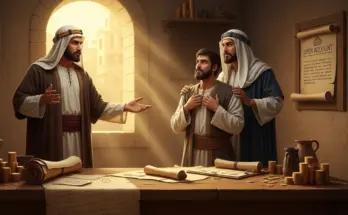The story of Jesus Christ begins in Bethlehem, a small town in the region of Judea, over 2,000 years ago. At that time, the Jewish people lived under Roman rule, longing for a promised Savior foretold by the prophets.
According to the New Testament, Jesus was born to Mary and Joseph, who were from Nazareth in Galilee (Luke 1:26–27). Mary, a young woman, was visited by the angel Gabriel and told she would miraculously conceive a son by the Holy Spirit. Joseph, a carpenter, accepted the divine role of being Jesus’ earthly father (Matthew 1:18–25).
When a Roman census required Joseph and Mary to travel to Bethlehem, they found no lodging available. Mary gave birth to Jesus in a humble stable, laying him in a manger (Luke 2:1–7). That same night, an angel appeared to shepherds in nearby fields, announcing the Savior’s birth. The shepherds hurried to see the baby and shared the good news with others (Luke 2:8–20).
Later, wise men from the East followed a special star that led them to Jesus. They brought gifts of gold, frankincense, and myrrh, recognizing him as King of the Jews (Matthew 2:1–12).
Jesus’ childhood is less detailed in Scripture, but one key story stands out. At age twelve, Jesus traveled with his family to Jerusalem for Passover. After the feast, Mary and Joseph realized Jesus was missing. They found him in the Temple, listening to and questioning the teachers. Even then, Jesus showed an awareness of his unique calling (Luke 2:41–52).
These early events are more than a heartwarming narrative. For Christians, Jesus’ birth fulfills Old Testament prophecies (Micah 5:2; Isaiah 7:14), showing God’s plan to send a Savior. His humble beginnings reflect his mission to identify with the lowly and bring hope to all.
The Ministry and Teachings of Jesus
Jesus’ public ministry began around age 30 after his baptism by John the Baptist (Matthew 3:13–17). Immediately after, he was led into the wilderness, where he fasted for 40 days and resisted temptation from the devil (Matthew 4:1–11).
From that point on, Jesus traveled throughout Galilee and Judea, teaching about the Kingdom of God and performing miracles. His central message was clear: God’s love and mercy are available to all who believe.
Jesus taught the importance of:
- Loving others as ourselves (Mark 12:31)
- Forgiving enemies and showing mercy (Matthew 5:43–48)
- Humility, generosity, and faith (Luke 6:20–38)
He told parables—short stories with spiritual meaning—to explain God’s truth in everyday language. At the heart of his teaching was this command:
“Love one another as I have loved you.” (John 13:34)
Jesus also called people to repent and believe in the good news. He healed the sick, calmed storms, cast out demons, and even raised the dead—demonstrating both his compassion and divine authority (Mark 1:29–34, Luke 8:22–25, John 11:38–44).
Though many followed him, others—especially religious leaders—felt threatened by his growing influence and challenged his authority.
The Last Days of Jesus Christ
Jesus’ final days began with his triumphal entry into Jerusalem, where crowds welcomed him as the Messiah, waving palm branches and shouting “Hosanna!” (Matthew 21:1–11). This moment, now remembered as Palm Sunday, marked the beginning of what Christians call Holy Week.
Once in Jerusalem, Jesus taught openly, confronted religious hypocrisy, and foretold the destruction of the Temple. These actions intensified the anger of the Jewish authorities.
On the night of his arrest, Jesus shared a final meal—now known as the Last Supper—with his disciples (Luke 22:14–20). He was then betrayed by Judas Iscariot, arrested in the Garden of Gethsemane, and taken before the Jewish council.
Despite Pilate’s hesitation, the crowd demanded Jesus’ crucifixion. He was sentenced to death, beaten, mocked, and forced to carry his cross to Golgotha. There he was crucified, dying after hours of suffering (Matthew 27:27–50). Even in death, Jesus forgave those who crucified him and committed his spirit to God.
The Crucifixion and Resurrection
Jesus’ death by crucifixion fulfilled Scripture and symbolized the ultimate sacrifice for sin (Isaiah 53). He was buried in a borrowed tomb, and a large stone sealed the entrance (Matthew 27:57–66).
On the third day—Sunday morning—his tomb was found empty. Angels announced that Jesus had risen (Luke 24:1–7). Over the next forty days, Jesus appeared to his disciples and many others, offering proof of his resurrection (1 Corinthians 15:3–8).
This miraculous event is the foundation of Christian faith. The resurrection affirms Jesus’ divinity and victory over sin and death. It gives believers hope of eternal life and assurance that God’s promises are true.
The Spread of Christianity
Before ascending into heaven, Jesus Christ gave his followers a mission:
“Go and make disciples of all nations…” (Matthew 28:19)
Empowered by the Holy Spirit on the day of Pentecost (Acts 2), the apostles began preaching the gospel with boldness. They traveled across the Roman Empire—into modern-day Turkey, Greece, Italy, and beyond—planting churches and baptizing believers.
The message of Jesus Christ appealed to many. In a world filled with oppression and injustice, the promise of salvation, forgiveness, and eternal life was a powerful hope. Early Christians formed close-knit communities that cared for the poor, the sick, and the outcast.
In the 4th century, Emperor Constantine‘s conversion led to Christianity becoming legal—and later the state religion—of the Roman Empire. From there, the faith spread globally through both missionary efforts and colonial expansion.
While this growth brought positive change, it also led to divisions, doctrinal disputes, and at times, misuse of Christian teaching. Still, through persecution and political challenges, the gospel continued to spread, and the Church endured.
The Legacy and Influence of Jesus Christ
More than two thousand years later, the life and teachings of Jesus Christ continue to shape individuals and societies. His call to love God and love others has become a moral foundation for millions.
Jesus’ example of humility, courage, and service inspires people to:
- Care for the poor and sick
- Forgive rather than retaliate
- Stand for justice even in the face of opposition
Throughout history, movements for human rights, charity, and reform have often been sparked by his message. From the abolition of slavery to modern humanitarian efforts, the influence of Jesus Christ is visible across the world.
At the same time, Christians have not always lived up to his teachings. The Church has experienced divisions, and at times, believers have misused Jesus’ name to justify harm. But despite these failures, the heart of his message remains a powerful force for good.
Final Thoughts on Jesus Christ
The life of Jesus Christ—from a manger in Bethlehem to a cross on Calvary and an empty tomb—offers the world a message of love, hope, and redemption. For new believers and seekers, his story is an invitation to explore who he is and what he taught.
As you continue your journey, consider this question:
How might the life and teachings of Jesus Christ shape your own story?
The book of Genesis is more than a record of creation—it’s the foundation of God’s redemptive story. From the first breath of life to the first promise of a Savior, the opening chapters point us toward Jesus in powerful and prophetic ways.



